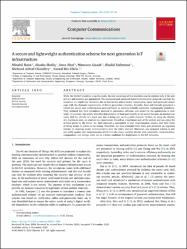| dc.contributor.author | Rana, Minahil | |
| dc.contributor.author | Shafiq, Akasha | |
| dc.contributor.author | Altaf, Izwa | |
| dc.contributor.author | Alazab, Mamoun | |
| dc.contributor.author | Mahmood, Khalid | |
| dc.contributor.author | Chaudhry, Shehzad Ashraf | |
| dc.contributor.author | Bin Zikria, Yousaf | |
| dc.date.accessioned | 2023-06-17T06:31:03Z | |
| dc.date.available | 2023-06-17T06:31:03Z | |
| dc.date.issued | 2021 | en_US |
| dc.identifier.issn | 0140-3664 | |
| dc.identifier.issn | 1873-703X | |
| dc.identifier.uri | https://hdl.handle.net/11363/4889 | |
| dc.description.abstract | While the 6G/IoT transition is on the cards, the real advantage of this transition can be realized only if the user
privacy and security are guaranteed. The smartcard and password based authentication protocols can help the
transition in a rapid way. However, due to insecurities and/or heavy computation, many such protocols cannot
cope with the dynamic requirements of future generation networks. Recently, Kaul and Awasthi presented a
robust and secure user authentication protocol based on resource friendly symmetric cryptography primitives.
They declared that their introduced protocol is convenient, efficient, and secure for the applications in realworld. In contrast, this article describes that protocol of Kaul and Awasthi is not secure because an attacker can
easily find the identity of a legal user that is being sent on the public channel. Further, by using the identity
of a legitimate user, an attacker can impersonate himself as a legitimate user of the system and can enjoy the
services given by the server. So, their protocol is susceptible to user impersonation attacks, and their claim
of being secure is proven to be wrong. Therefore, we have extended their work and presented an upgraded
scheme by ensuring secure communication over the entire channel. Moreover, our proposed scheme is safe
not solely against user impersonation attack but also major security attacks with reasonable communication,
computation, and storage costs and is a better candidate for deployment in 6G/IoT networks. | en_US |
| dc.language.iso | eng | en_US |
| dc.publisher | ELSEVIER, RADARWEG 29, 1043 NX AMSTERDAM, NETHERLANDS | en_US |
| dc.relation.isversionof | 10.1016/j.comcom.2020.11.002 | en_US |
| dc.rights | info:eu-repo/semantics/openAccess | en_US |
| dc.rights | Attribution-NonCommercial-NoDerivs 3.0 United States | * |
| dc.rights.uri | http://creativecommons.org/licenses/by-nc-nd/3.0/us/ | * |
| dc.subject | Authentication | en_US |
| dc.subject | 6G/IoT security | en_US |
| dc.subject | Network Security | en_US |
| dc.subject | User impersonation | en_US |
| dc.title | A secure and lightweight authentication scheme for next generation IoT infrastructure | en_US |
| dc.type | article | en_US |
| dc.relation.ispartof | Computer Communications | en_US |
| dc.department | Mühendislik ve Mimarlık Fakültesi | en_US |
| dc.authorid | https://orcid.org/0000-0002-1928-3704 | en_US |
| dc.authorid | https://orcid.org/0000-0001-5046-7766 | en_US |
| dc.authorid | https://orcid.org/0000-0002-9321-6956 | en_US |
| dc.authorid | https://orcid.org/0000-0002-6570-5306 | en_US |
| dc.identifier.volume | 165 | en_US |
| dc.identifier.startpage | 85 | en_US |
| dc.identifier.endpage | 96 | en_US |
| dc.relation.publicationcategory | Makale - Uluslararası Hakemli Dergi - Kurum Öğretim Elemanı | en_US |
| dc.institutionauthor | Chaudhry, Shehzad Ashraf | |



















